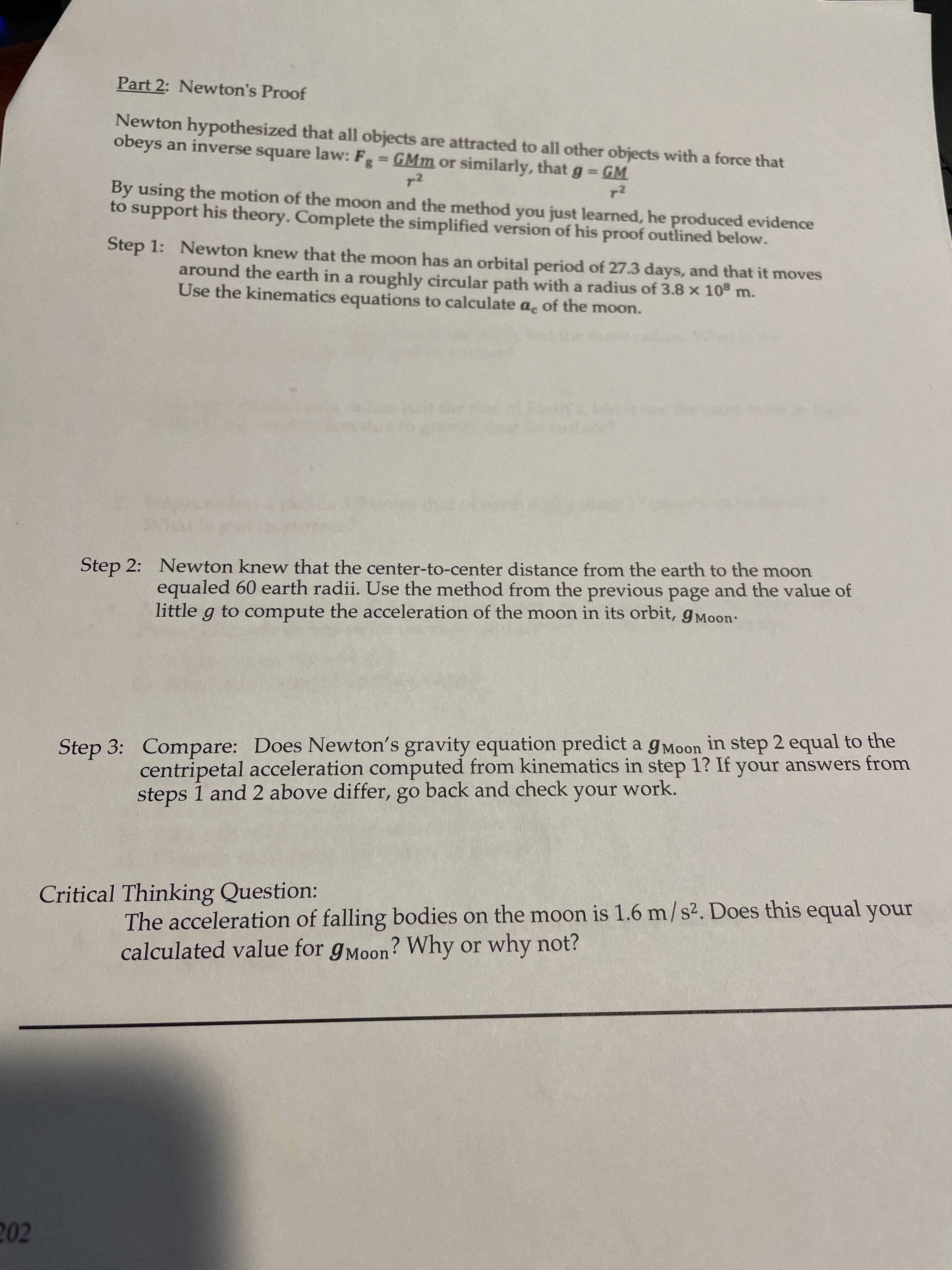Part 2: Newton's Proof Newton hypothesized that all objects are attracted to all other objects with a force that obeys an inverse square law: F GMm or similarly, that g = = GM %3D %3D By using the motion of the moon and the method you just learned, he produced evidence support his theory. Complete the simplified version of his proof outlined below. to Step 1: Newton knew that the moon has an orbital period of 27.3 days, and that it moves around the earth in a roughly circular path with a radius of 3.8 x 108 m. Use the kinematics equations to calculate a, of the moon. Step 2: Newton knew that the center-to-center distance from the earth to the moon equaled 60 earth radii. Use the method from the previous page and the value of little g to compute the acceleration of the moon in its orbit, gMoon Step 3: Compare: Does Newton's gravity equation predict a gMoon in step 2 equal to the centripetal acceleration computed from kinematics in step 1? If your answers from steps 1 and 2 above differ, go back and check your work. Critical Thinking Question: The acceleration of falling bodies on the moon is 1.6 m/ s2. Does this equal your calculated value for gMoon? Why or why not? 202
Part 2: Newton's Proof Newton hypothesized that all objects are attracted to all other objects with a force that obeys an inverse square law: F GMm or similarly, that g = = GM %3D %3D By using the motion of the moon and the method you just learned, he produced evidence support his theory. Complete the simplified version of his proof outlined below. to Step 1: Newton knew that the moon has an orbital period of 27.3 days, and that it moves around the earth in a roughly circular path with a radius of 3.8 x 108 m. Use the kinematics equations to calculate a, of the moon. Step 2: Newton knew that the center-to-center distance from the earth to the moon equaled 60 earth radii. Use the method from the previous page and the value of little g to compute the acceleration of the moon in its orbit, gMoon Step 3: Compare: Does Newton's gravity equation predict a gMoon in step 2 equal to the centripetal acceleration computed from kinematics in step 1? If your answers from steps 1 and 2 above differ, go back and check your work. Critical Thinking Question: The acceleration of falling bodies on the moon is 1.6 m/ s2. Does this equal your calculated value for gMoon? Why or why not? 202
Glencoe Physics: Principles and Problems, Student Edition
1st Edition
ISBN:9780078807213
Author:Paul W. Zitzewitz
Publisher:Paul W. Zitzewitz
Chapter7: Gravitation
Section: Chapter Questions
Problem 89A
Related questions
Question
100%

Transcribed Image Text:Part 2: Newton's Proof
Newton hypothesized that all objects are attracted to all other objects with a force that
obeys an inverse square law: F GMm or similarly, that g =
= GM
%3D
%3D
By using the motion of the moon and the method you just learned, he produced evidence
support his theory. Complete the simplified version of his proof outlined below.
to
Step 1: Newton knew that the moon has an orbital period of 27.3 days, and that it moves
around the earth in a roughly circular path with a radius of 3.8 x 108 m.
Use the kinematics equations to calculate a, of the moon.
Step 2: Newton knew that the center-to-center distance from the earth to the moon
equaled 60 earth radii. Use the method from the previous page and the value of
little g to compute the acceleration of the moon in its orbit, gMoon
Step 3: Compare: Does Newton's gravity equation predict a gMoon in step 2 equal to the
centripetal acceleration computed from kinematics in step 1? If your answers from
steps 1 and 2 above differ, go back and check your work.
Critical Thinking Question:
The acceleration of falling bodies on the moon is 1.6 m/ s2. Does this equal your
calculated value for gMoon? Why or why not?
202
Expert Solution
This question has been solved!
Explore an expertly crafted, step-by-step solution for a thorough understanding of key concepts.
This is a popular solution!
Trending now
This is a popular solution!
Step by step
Solved in 4 steps with 3 images

Knowledge Booster
Learn more about
Need a deep-dive on the concept behind this application? Look no further. Learn more about this topic, physics and related others by exploring similar questions and additional content below.Recommended textbooks for you

Glencoe Physics: Principles and Problems, Student…
Physics
ISBN:
9780078807213
Author:
Paul W. Zitzewitz
Publisher:
Glencoe/McGraw-Hill

Astronomy
Physics
ISBN:
9781938168284
Author:
Andrew Fraknoi; David Morrison; Sidney C. Wolff
Publisher:
OpenStax

Glencoe Physics: Principles and Problems, Student…
Physics
ISBN:
9780078807213
Author:
Paul W. Zitzewitz
Publisher:
Glencoe/McGraw-Hill

Astronomy
Physics
ISBN:
9781938168284
Author:
Andrew Fraknoi; David Morrison; Sidney C. Wolff
Publisher:
OpenStax